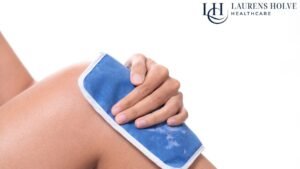Picture this: I’m halfway through a friendly game of five-a-side, surging ahead for the winning goal, when—ouch—a muscle in my thigh twangs like an overtight violin string. Should I hobble over to the freezer or fire up the kettle for that old tartan heat pack? Turns out, I’m not the only one who’s mulled over the icy/hot conundrum after a pulled muscle. Let’s wade through the folklore, the evidence, and a smidgen of personal embarrassment to find out what really brings relief.
When to Use Ice: The Icy Truth About Acute Muscle Pain
If you’ve ever pulled a muscle, you’ll know the immediate sting that follows. The question always comes up: should you reach for ice, or is heat the better option? In the world of acute injuries—think fresh muscle strains or sprains—ice therapy is widely regarded as the first line of defence. But why is that, and how do you use it effectively without causing more harm than good?
The Science Behind Ice Therapy for Acute Injuries
Research shows that ice therapy is most effective within the first 24 to 72 hours after a pulled muscle or similar acute injury. The reason is simple: when you injure a muscle, your body’s natural response is to send blood rushing to the area. This causes swelling, inflammation, and often, that sharp, throbbing pain you wish would disappear. Applying a cold compress—whether it’s a fancy ice pack or a humble bag of frozen peas—constricts blood vessels. This reduces blood flow, minimises swelling, and helps numb the pain.
As Dr. Sally Jones puts it:
“Cryotherapy is the gold standard for initial muscle injuries.”
The benefits of ice therapy don’t stop at pain relief. By limiting inflammation and bleeding within the muscle tissue, you’re giving your body a better chance to heal efficiently. Studies indicate that ice therapy benefits can extend up to two weeks after the initial injury, although the first 72 hours are considered optimal for intervention.
Practical Dos and Don’ts of Ice Pack Application
Let’s get practical. You don’t need high-tech gadgets to get the ice therapy benefits you’re after. In fact, a mate of mine swears by a bag of peas—he claims it’s more shapeable than most commercial ice packs, moulding perfectly to the contours of a sore calf or shoulder. The key, though, is in the application.
- Never apply ice packs directly to your skin. Always use a towel or cloth as a barrier to prevent ice burns or nerve damage.
- Apply the cold compress for 15–20 minutes at a time, then remove it for at least the same duration before reapplying.
- Monitor your skin for excessive redness, numbness, or tingling—these are signs you may be overdoing it.
- Continue ice therapy for up to two weeks if swelling or pain persists, but listen to your body. If symptoms worsen or don’t improve, seek professional advice.
It’s tempting to think more is better, but overuse of ice therapy can backfire. Extended exposure or direct contact can lead to ice burns or even nerve damage. Always err on the side of caution.
Why Timing Matters: The 24–72 Hour Window
The timing of ice pack application is crucial. The first 24 to 72 hours after an acute injury are when inflammation and swelling peak. This is when ice therapy is most effective at reducing these responses. After this window, the body begins to transition from the inflammatory phase to the healing phase, and the benefits of cold therapy start to diminish. Still, if swelling or pain lingers, research suggests you can continue using cold compresses for up to two weeks.
Individual Response: Listen to Your Body
It’s worth noting that everyone responds differently to ice therapy. Some people find immediate relief, while others may experience discomfort or heightened sensitivity. If you notice increased pain, numbness, or skin changes, stop the treatment and consult a healthcare professional. There’s no one-size-fits-all approach, so trust your instincts and err on the side of caution.
Everyday Ice Therapy: Real-World Tips
You don’t need to invest in expensive equipment to benefit from ice therapy. A simple bag of frozen vegetables, wrapped in a tea towel, can be just as effective as a branded cold compress. The main thing is to ensure even coverage and avoid direct skin contact. And don’t forget—sometimes, the simplest solutions are the best. My mate’s bag of peas has seen more action than most gym memberships.
In summary, when it comes to acute injuries like pulled muscles, ice therapy is your go-to for the first few days. Use it wisely, follow best practices, and you’ll give your body the best chance to recover swiftly and safely.
Heat Therapy Effectiveness: Warming Up to Recovery
When it comes to pulled muscles, the question of whether to reach for a warm compress or an ice pack is one that continues to spark debate. Yet, once you move beyond the initial swelling and acute pain, heat therapy often emerges as the unsung hero in the recovery process. Let’s explore why, when, and how to use heat safely—and when it’s best left on the shelf.
How Heat Therapy Works: The Science Behind the Warmth
At its core, heat therapy works by dilating blood vessels, which increases blood flow to the affected area. This boost in circulation brings fresh oxygen and nutrients to your muscles, helping to clear out metabolic waste and speed up the healing process. Research shows that heat therapy increases metabolism, promotes blood circulation, and reduces muscle pain and stiffness—making it especially effective for chronic muscle pain and the later stages of recovery.
Unlike ice, which is best suited for acute injuries and the first 24 to 72 hours after trauma, heat therapy comes into its own once the initial swelling has subsided. As Professor David Turner puts it:
“Within 48 hours post-injury, heat can aid muscle relaxation and recovery without aggravating inflammation.”
When Heat Therapy Shines: Ideal Timing and Use Cases
Timing is everything with heat therapy effectiveness. If you apply heat too soon—while swelling is still present—you risk making things worse by increasing inflammation. But after the first 48 hours, when the acute phase has passed, heat becomes a powerful tool for soothing lingering aches and loosening tight, knotted muscles.
- Best for: Post-acute-phase pain, muscle stiffness, and chronic aches.
- Common delivery methods: Hot water bottles, heated pads, wheat bags, and warm compresses.
- Not for: Fresh injuries with active swelling or bruising.
Think of heat therapy as your go-to for those mornings when your back feels stiff or after a long day at your desk leaves your shoulders in knots. It’s not about numbing pain, but rather encouraging your body’s natural healing processes by relaxing the muscles and calming the nervous system.
Personal Tangent: The Wheat Bag Incident
On a more personal note, I’ll admit to once falling asleep with a wheat bag nestled against my lower back. The comfort was undeniable—like a gentle hug for sore muscles. But, and this is crucial, always follow heat pack precautions. Never use a hot pack directly on bare skin, and never leave it on for extended periods, especially if you’re likely to doze off. Overheating or burns are a real risk, and it’s all too easy to forget safety when you’re enjoying that soothing warmth.
Heat Therapy Benefits: More Than Just Comfort
Beyond immediate relief, the benefits of heat therapy extend to improved flexibility, reduced muscle spasms, and a general sense of relaxation. Studies indicate that heat can help calm the nervous system, which is particularly valuable if you’re dealing with ongoing discomfort or stress-related muscle tension.
Some of the key advantages include:
- Enhanced blood flow and oxygen delivery to injured tissues
- Reduced muscle stiffness and improved range of motion
- Relief from chronic pain and post-exercise soreness
For athletes and anyone with recurring muscle issues, a warm compress or heat pack can be a staple in your recovery toolkit. Just remember: it’s not a cure-all, and it won’t address underlying injuries that require medical attention.
Heat Pack Precautions: When to Hold Back
While the effectiveness of heat therapy is well documented, there are important caveats. Never apply heat to a fresh injury, as it can worsen swelling and inflammation. Always use a protective layer—like a towel—between your skin and the heat source. Limit sessions to 15-20 minutes at a time, and check the temperature before applying.
- Avoid heat if: Swelling, bruising, or acute pain is still present.
- Monitor skin: Watch for redness, blistering, or discomfort.
- Consult a professional: If you’re unsure, seek advice before using heat therapy on a new injury.
In summary, heat therapy is a powerful ally for recovery—just be sure to use it wisely, and always respect the signals your body sends you.
Contrast Water Therapy & Wild Cards: Is There Middle Ground?
When it comes to muscle recovery methods, the debate between cold vs warm therapy has long dominated the conversation. Yet, there’s a growing interest in a third approach—contrast water therapy. This method, which alternates between hot and cold treatments, is gaining traction among athletes and physiotherapists alike. But is it truly the middle ground for pain relief methods, or just another passing trend?
Contrast water therapy is sometimes described as a ‘thermal rollercoaster’. The idea is simple: by switching between hot and cold, you can potentially speed up recovery and reduce inflammation. The science behind this is rooted in how temperature affects blood flow. Cold therapy constricts blood vessels, reducing swelling and numbing pain, while heat therapy dilates vessels, encouraging circulation and relaxing tight muscles. By alternating between the two, you may be able to harness the benefits of both—promoting blood flow while controlling post-activity swelling.
Research shows that contrast water therapy can be useful for both acute recovery and ongoing muscle soreness. Some studies indicate that athletes who use this method report less muscle pain and faster recovery times. However, it’s important to note that the evidence is still evolving. As Dr. Priya Patel puts it,
“Alternating heat and cold can be an effective method for muscle recovery in some individuals.”
But, just as with any therapy, individual response varies. What works wonders for one person may do little for another.
To put this into perspective, imagine a wild card scenario: if dogs could choose their own recovery method after a long run, would they curl up on a cool kitchen tile or stretch out in a sunny patch on the rug for their sore paws? There’s no universal answer, and the same applies to humans. Personal preference, comfort, and even mood can influence which therapy feels best on any given day.
If you’re considering contrast water therapy at home, it’s wise to proceed with caution. There’s no universally agreed-upon duration for each temperature phase, but athlete protocols often suggest alternating between hot and cold for one to three minutes each. Always test the water temperature before starting to avoid burns or frostbite, and keep sessions brief. A simple way to try this at home is by alternating between a warm shower and a cold rinse, or using two buckets—one with warm water, the other with ice water—for soaking sore limbs.
It’s also worth noting that contrast water therapy isn’t just for elite athletes or those with access to high-tech rehab facilities. Many people adapt the technique for everyday use, whether it’s after a tough workout, a long day on your feet, or even just to soothe ongoing aches. The key is to listen to your body. If you notice increased pain, swelling, or any unusual symptoms, it’s time to stop and consult a healthcare professional. Persistent or severe muscle issues should never be ignored.
While contrast water therapy offers a promising blend of benefits, it’s not a one-size-fits-all solution. Some people find the rapid temperature changes invigorating, while others may feel uncomfortable or even experience increased pain. This is where context and caution become crucial. If you have underlying health conditions, circulatory problems, or are recovering from surgery, always seek personalised guidance from a medical professional before trying new muscle recovery methods.
In conclusion, the great ice vs heat debate doesn’t have to be an either/or proposition. Contrast water therapy presents a compelling middle ground, combining the best aspects of both cold and warm therapy. As research continues to evolve, and as more people experiment with these pain relief methods, it’s clear that personal preference and professional advice should guide your choices. Sometimes, the best approach is the one that feels right for you—whether that’s a cold pack, a hot water bottle, or a carefully balanced dance between the two.
TL;DR: For pulled muscles, ice is usually your best bet in the first couple of days, then consider heat for ongoing stiffness—just don’t mix them up. Your body will thank you, your future self even more so.






